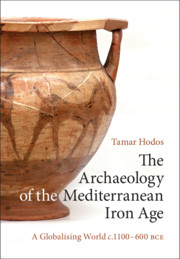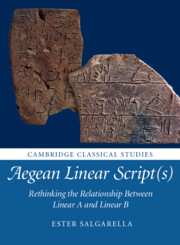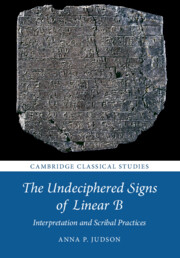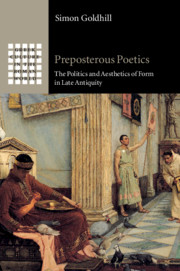Refine search
Actions for selected content:
60618 results in Classical studies (general)

The Archaeology of the Mediterranean Iron Age
- A Globalising World c.1100–600 BCE
-
- Published online:
- 12 September 2020
- Print publication:
- 17 September 2020

Aegean Linear Script(s)
- Rethinking the Relationship Between Linear A and Linear B
-
- Published online:
- 10 September 2020
- Print publication:
- 01 October 2020
SOME PERSPECTIVES ON CALLIMACHUS’ HYMNS - (M.) Brumbaugh The New Politics of Olympos. Kingship in Kallimachos’ Hymns. Pp. xviii + 298, ills. New York: Oxford University Press, 2019. Cased, £55, US$85. ISBN: 978-0-19-005926-2.
-
- Journal:
- The Classical Review / Volume 70 / Issue 2 / October 2020
- Published online by Cambridge University Press:
- 07 September 2020, pp. 349-351
- Print publication:
- October 2020
-
- Article
- Export citation

The Undeciphered Signs of Linear B
- Interpretation and Scribal Practices
-
- Published online:
- 04 September 2020
- Print publication:
- 24 September 2020
A REVISED TRANSLATION OF CICERO'S DE RE PUBLICA AND DE LEGIBUS - (J.E.G.) Zetzel (trans.) Cicero: On the Commonwealth and On the Laws. Second edition. Pp. lx + 212. Cambridge: Cambridge University Press, 2017 (first edition 1999). Paper, £17.99 (Cased, US$54.99). ISBN: 978-1-316-50556-4 (978-1-107-14006-6 hbk).
-
- Journal:
- The Classical Review / Volume 70 / Issue 2 / October 2020
- Published online by Cambridge University Press:
- 03 September 2020, pp. 377-378
- Print publication:
- October 2020
-
- Article
- Export citation
THE CLASSICS AND MODERNIST TRANSLATORS - (M.) Hickman, (L.) Kozak (edd.) The Classics in Modernist Translation. Pp. xviii + 264, ills. London and New York: Bloomsbury Academic, 2019. Cased, £85, US$114. ISBN: 978-1-350-04095-3.
-
- Journal:
- The Classical Review / Volume 70 / Issue 2 / October 2020
- Published online by Cambridge University Press:
- 03 September 2020, pp. 516-518
- Print publication:
- October 2020
-
- Article
- Export citation
WOMEN AND POLITICS IN LATE REPUBLICAN ROME - (F.) Rohr Vio Le custodi del potere. Donne e politica alla fine della repubblica Romana. (Piccoli saggi 66.) Pp. 268. Rome: Salerno Editrice, 2019. Paper, €22. ISBN: 978-88-6973-369-7.
-
- Journal:
- The Classical Review / Volume 70 / Issue 2 / October 2020
- Published online by Cambridge University Press:
- 03 September 2020, pp. 446-448
- Print publication:
- October 2020
-
- Article
- Export citation
MARITIME POWER NETWORKS - (R.) Strootman, (F.) van den Eijnde, (R.) van Wijk (edd.) Empires of the Sea. Maritime Power Networks in World History. (Cultural Interactions in the Mediterranean 4.) Pp. x + 361, b/w & colour ills, b/w & colour maps. Leiden and Boston: Brill, 2020. Cased, €119, US$143. ISBN: 978-90-04-40766-4.
-
- Journal:
- The Classical Review / Volume 70 / Issue 2 / October 2020
- Published online by Cambridge University Press:
- 03 September 2020, pp. 411-414
- Print publication:
- October 2020
-
- Article
- Export citation
LEKTA IN STOIC THOUGHT - (A.) Bronowski The Stoics on Lekta. All There Is to Say. Pp. xiv + 478. Oxford: Oxford University Press, 2019. Cased, £100, US$130. ISBN: 978-0-19-884288-0.
-
- Journal:
- The Classical Review / Volume 70 / Issue 2 / October 2020
- Published online by Cambridge University Press:
- 03 September 2020, pp. 347-349
- Print publication:
- October 2020
-
- Article
- Export citation
THE OPPONENTS OF ALEXANDER THE GREAT - (W.) Heckel In the Path of Conquest. Resistance to Alexander the Great. Pp. xvi + 348, maps. New York: Oxford University Press, 2020. Cased, £22.99, US$34.95. ISBN: 978-0-19-007668-9.
-
- Journal:
- The Classical Review / Volume 70 / Issue 2 / October 2020
- Published online by Cambridge University Press:
- 03 September 2020, pp. 436-438
- Print publication:
- October 2020
-
- Article
- Export citation
THE CLASSICAL HERO AND MASS MEDIA - (R.) López Gregoris, (C.) Macías Villalobos (edd.) The Hero Reloaded. The Reinvention of the Classical Hero in Contemporary Mass Media. (IVITRA Research in Linguistics and Literature 23.) Pp. xiv + 160, colour ills. Amsterdam and Philadelphia: John Benjamins Publishing Company, 2020. Cased, €90, US$135. ISBN: 978-90-272-0495-0.
-
- Journal:
- The Classical Review / Volume 70 / Issue 2 / October 2020
- Published online by Cambridge University Press:
- 03 September 2020, pp. 523-526
- Print publication:
- October 2020
-
- Article
- Export citation
CLASSICALLY-INSPIRED WOMEN WRITERS IN THE RENAISSANCE - (F.) D'Alessandro Behr Arms and the Woman. Classical Tradition and Women Writers in the Venetian Renaissance. Pp. viii + 285. Columbus: The Ohio State University Press, 2018. Cased, US$89.95 (Paper, US$34.95). ISBN: 978-0-8142-1371-1 (978-0-8142-5477-6 pbk).
-
- Journal:
- The Classical Review / Volume 70 / Issue 2 / October 2020
- Published online by Cambridge University Press:
- 03 September 2020, pp. 509-511
- Print publication:
- October 2020
-
- Article
- Export citation
TWO THOUSAND CITIES - (L.) De Ligt, (J.) Bintliff (edd.) Regional Urban Systems in the Roman World, 150 bce – 250 ce. (Mnemosyne Supplements 431.) Pp. xviii + 582, b/w & colour figs, b/w & colour maps. Leiden and Boston: Brill, 2020. Cased, €136, US$164. ISBN: 978-90-04-41433-4.
-
- Journal:
- The Classical Review / Volume 70 / Issue 2 / October 2020
- Published online by Cambridge University Press:
- 03 September 2020, pp. 457-460
- Print publication:
- October 2020
-
- Article
- Export citation
STUDIES ON RITUALS IN EARLY GREECE - (I.S.) Lemos, (A.) Tsingarida (edd.) Beyond the Polis. Rituals, Rites, and Cults in Early and Archaic Greece (12th–6th Centuries bc). (Études d'Archéologie 15.) Pp. 304, figs, b/w & colour ills, b/w & colour maps. Brussels: CreA-Patrimoine, 2019. Paper, €80. ISBN: 978-2-96020292-2.
-
- Journal:
- The Classical Review / Volume 70 / Issue 2 / October 2020
- Published online by Cambridge University Press:
- 03 September 2020, pp. 469-472
- Print publication:
- October 2020
-
- Article
- Export citation
CHILDREN ON THE TRAGIC STAGE - (E.M.) Griffiths Children in Greek Tragedy. Pathos and Potential. Pp. viii + 328. Oxford: Oxford University Press, 2020. Cased, £75, US$99. ISBN: 978-0-19-882607-1.
-
- Journal:
- The Classical Review / Volume 70 / Issue 2 / October 2020
- Published online by Cambridge University Press:
- 03 September 2020, pp. 325-327
- Print publication:
- October 2020
-
- Article
- Export citation
(J.) Beneker (trans.) Plutarch: How to Be a Leader. An Ancient Guide to Wise Leadership. Pp. xxvi + 374. Princeton and Oxford: Princeton University Press, 2019. Cased, £13.99, US$16.95. ISBN: 978-0-691-19211-6.
-
- Journal:
- The Classical Review / Volume 70 / Issue 2 / October 2020
- Published online by Cambridge University Press:
- 28 August 2020, p. 529
- Print publication:
- October 2020
-
- Article
- Export citation
HERO AND LEANDER THROUGH THE AGES - (B.) Murdoch The Reception of the Legend of Hero and Leander. (Brill's Companions to Classical Reception 19.) Pp. xii + 409. Leiden and Boston: Brill, 2019. Cased, €149, US$179. ISBN: 978-90-04-40093-1.
-
- Journal:
- The Classical Review / Volume 70 / Issue 2 / October 2020
- Published online by Cambridge University Press:
- 28 August 2020, pp. 505-507
- Print publication:
- October 2020
-
- Article
- Export citation
A COMMENTARY ON VENANTIUS FORTUNATUS’ LIFE OF ST MARTIN - (N.M.) Kay (ed., trans.) Venantius Fortunatus: Vita Sancti Martini. Prologue and Books I–II. (Cambridge Classical Texts and Commentaries 59.) Pp. viii + 580. Cambridge: Cambridge University Press, 2020. Cased, £120, US$156. ISBN: 978-1-108-42584-1.
-
- Journal:
- The Classical Review / Volume 70 / Issue 2 / October 2020
- Published online by Cambridge University Press:
- 28 August 2020, pp. 406-408
- Print publication:
- October 2020
-
- Article
- Export citation

Preposterous Poetics
- The Politics and Aesthetics of Form in Late Antiquity
-
- Published online:
- 27 August 2020
- Print publication:
- 17 September 2020
THE CONTEXT OF PLATO'S ACADEMY - (P.) Kalligas, (C.) Balla, (E.) Baziotopoulou-Valavani, (V.) Karasmanis (edd.) Plato's Academy. Its Workings and its History. Pp. xii + 434, b/w & colour ills, b/w & colour maps. Cambridge: Cambridge University Press, 2020. Cased, £90, US$120. ISBN: 978-1-108-42644-2.
-
- Journal:
- The Classical Review / Volume 70 / Issue 2 / October 2020
- Published online by Cambridge University Press:
- 24 August 2020, pp. 344-347
- Print publication:
- October 2020
-
- Article
- Export citation
